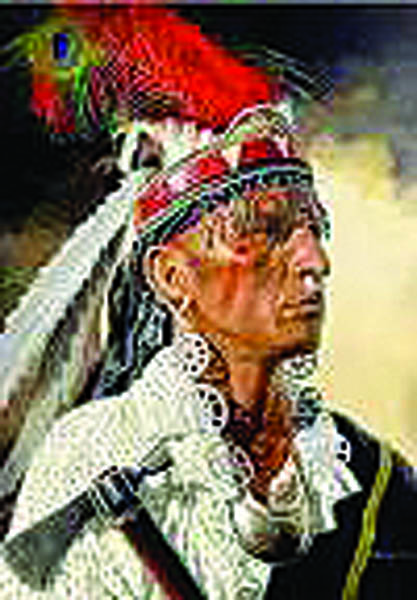Settlers along the Wilderness Road, Part 4
Indians on the warpath

CHIEF BENGE (Scottish Tarta Soceity)
Within a few days Daniel organized a small troop of men and proceeded northward to fight Chief Cornstalk and his warriors. Boone’s group was soon overtaken by a messenger with orders to return. They were needed to defend the area fortifications, particularly Moore’s Fort at the time.
The Indians were seemingly in several places at once.
Efforts had been made to strengthen Moore’s Fort when word came that Logan, the chief of the Mingoes had ravaged Fort Blackmore and killed two men and a number of cattle. Daniel Boone along his son Israel and several men went 20 miles down the river to help them.
Captain Blackmore showed Daniel a Cherokee war-club that was left behind during the ambush. The war-club indicated to Daniel that the Cherokees had joined the warring Indian nations to the north.
“Men this means war right here on the Clinch,” Blackmore said. “Martin’s, Mump’s, Moore’s, all of the forts are in danger. We have only 11 men here. We need more. We need a captain over all of our forts. Boone, will you take our command?”
Boone sat silently before saying, “If you need help, call on us. We’ll come. You must always stay alert. Put out sentries and keep a close watch in every direction.”
It seemed they found everyone within the stockade hungry and frightened when they arrived at Moore’s Fort.
The women and children were afraid to go outside and milk the cows and the men had abandoned their hunting in the woods in fear of Logan’s warriors. They only made short trips outside to set and check animal traps.
Logan was a mighty hunter, excellent marksman and a “friend of the white man for many moons.” He was liked and respected for his honesty and loyalty by the whites and Indians alike. He was kind to women and children and treated everyone with dignity.
Logan expected his courtesy to be returned but several of his relatives had been killed by settlers a few years before. He put that behind but on April 30, 1774 a company of nine Indians including several of his family left his camp to visit a man by the name of Greathouse.
Greathouse proceeded to get the Indians drunk and then he and his associates cruelly murdered them. Chief Logan was greatly upset over the loss of his relations and loved ones. It was more than he could stand.
He began at once to raid settlements with small bands of Indians. On the first series of raids he took thirteen scalps, six of the number were children.
In July of 1774 the Mingoes captured William Robertson and condemned him to be tortured at the stake. Logan offered his freedom if he would assist him in writing a letter to Captain Cresap who he blamed for the death of his family members. Robertson gladly complied in order to save his skin although he had to rewrite the letter three times.
Each time the angry chief wanted the message to be stronger. Logan then visited the Cherokees and induced some of the bloodthirsty young warriors to join him.
A few days later a messenger arrived at Fort Blackmore telling of Logan’s warriors attacking the Holston settlement. They struck John Roberts’ home and all were killed but one. The message that Robertson had written for Logan was left behind.
“To Captain Cresap, why did you kill my people on Yellow Creek,” it began. “The white people killed my kin a great while ago and I forgot about it but then you killed my kin on Yellow Creek and took my cousin prisoner. I then decided I must kill too.” Logan’s mark concluded the statement.
Daniel Boone emphasized the importance of constantly being watchful. Sentries should be ever-present and changed frequently in an effort to keep them alert. The women and children need to stay inside the fort except for short trips to fetch water. The trips taken by the men were short as well, mostly to set traps and check them periodically.
“Logan and his men are in the woods,” one of the trappers yelled as he hurried back into the fort one day. “He shot John Duncan. We have to hurry if we are to save him.”
When Daniel and the men arrived at the scene they found Duncan dead. He had been scalped. Boone and the men pursued the Indians, cautiously and diligently, deep into the night but they were not to be found.
Jacob Lewis and his family were not allowed to stay when they arrived at Martin’s Fort with his wife and seven childre in the spring of 1775.
He was known to have a bad reputation. He left and built a cabin on Stock Creek where he supported his family by hunting.
At the height of the Indian uprising, Lewis was advised to move his family to one of the settlements. He refused, saying the Indians would never find them where they were living. A few months later he was proven wrong when they were all killed and scalped.
Terror was amuck along the series of forts from Cumberland Gap to beyond the Clinch. The settlers in each of the forts expected Logan and his marauding Mingoes or the Cherokees to strike them next.
“Fort Blackmore was attacked last night,” a messenger said excitedly as he dismounted one morning. “Dale Carter was on the river bank when he saw the Indians. He yelled out ‘murder, murder’ as they overtook him. They want riflemen to come along as they trail the Indians.”
Boone along witgh his son Israel, Captain Daniel Smith and thirty men hurried to Fort Blackmore where they found dogs barking, cows bellowing and the people afright. Captain Blackmore petitioned the military headquarters and Boone was made a captain and put in full command of several forts including Moore’s, Fort Blackmore and Cowan’s.
On one occasion when Boone traveled along the series of forts to check on their safety he visited and slept beside the grave of his son, James.
News of the attacks on Fort Blackmore and Moore’s Fort spread rapidly and several alarmed settlers fled their homes for safer settlements.
Soon Chief Cornstalk was defeated on the Ohio River but the settlers remained fearful of attacks. Governor Dunsmore called a meeting of many Indian chiefs in hopes of having them sign a treaty to end the war.
Cornstalk, the chief of the Shawnee nation, charged that white people caused the war by murdering Indians at Captina and Yellow Creek.
His tone of voice was so loud during his lengthy speech that he could be heard throughout the camp.
Chief Logan refused to attend but sent his speech by an interpreter.
“I am a warrior, not a peacemaker,” he said. “I fed white men who were hungry. I clothed white men who were cold and needed warmth. Even during a long bloody battle Logan remained in camp, an advocate for peace. My tribesmen pointed as I passed, calling me a friend of the white man and not of my fellow men.
“I even thought of living with the white men until Colonel Cresap, in cold blood and unprovoked, murdered all the family of Logan, my family, not even sparing my women and children. Revenge runs so deep in my veins. I have killed many. I rejoice for my brothers at the beams of peace but I cannot harbor such thoughts. Who is there to mourn for Logan? Not one.”
Copyright 2022, Jadon Gibson
Joseph Martin returns next week in Jadon’s story From the Mountains. His stories are both historical and nostalgic in nature. Don’t miss a single issue!
Thanks to Lincoln Memorial University, Alice Lloyd College and the Museum of Appalachia for their assistance.

